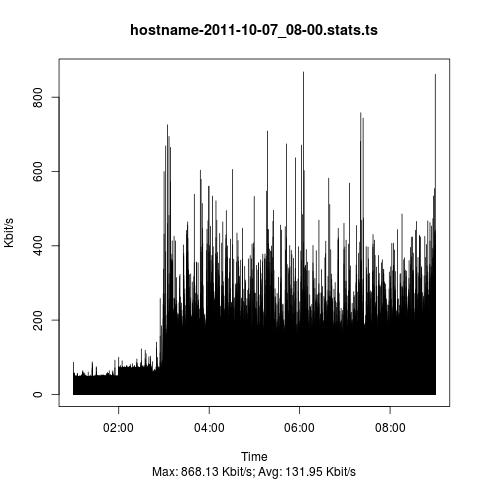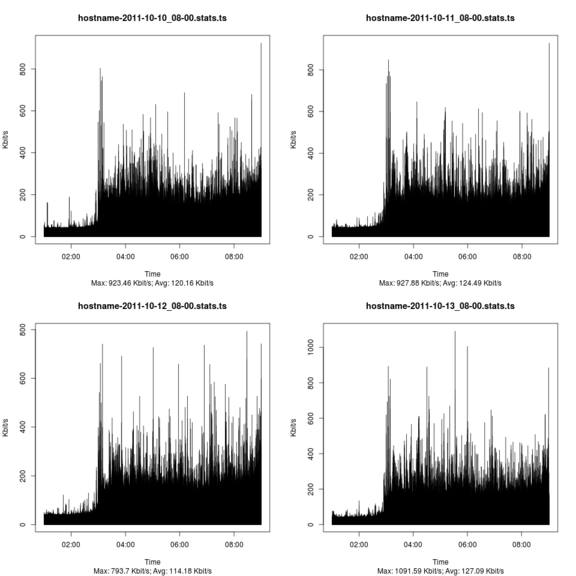Visualize pcap file data with R
One nice day I was given orders to produce network usage statistics to find eventual bursts in the network stream. Right from the start I faced two problems. Firtly the network monitoring software was graphing the network flow only every minute which was too coarse and secondly the interface was connected to a switch I had no control over at all, a mirror port had to be ruled out. The assignment was to collect data for a week and then look at the numbers.
I was unsure how to go about it in the first place. To not fall behind I ran tcpdump on the hosts in question until the week was over. That left me with a bit of time to figure out how to process the pcap dump data. After a lot of searching I finally came across a nifty feature in tshark allowing me to aggregate bandwidth on a per second basis. Below is a short recipe how to create graphs from captured network traffic.
Goal
Create a graph from a pcap capture file with a precision of one second.
Prerequisites
- A capture file the wireshark suite understands. E.g. pcap or Solaris snoop among others.
- tshark
- R
- ImageMagick's montage [optional]
Howto
Aggregate traffic with tshark
To properly graph the data tshark needs to generate statistic on a per second basis. The below command will achive this.
tshark -q -z 'io,stat,1' -r <PcapFile> > <StatisticsFile>
The output is looking something like the excerpt below.
===================================================================
IO Statistics
Interval: 1.000 secs
Column #0:
| Column #0
Time |frames| bytes
000.000-001.000 62 5578
001.000-002.000 62 5386
002.000-003.000 62 5692
003.000-004.000 62 5968
004.000-005.000 62 5428
005.000-006.000 62 5838
006.000-007.000 62 5912
The only problem with the output above is that the time is relative to the start of the pcap file.
Produce a graph with R
To produce the graph in PDF or PNG format R is used. There are a couple of things that need to be adjusted before running the script.
- The number of lines to skip when reading the file in the above example that would be 7 but your milage may vary. The variable to assign the value is skip.header
- tshark prints a comment line at the end of the file that has to be set with the comment.char variable in the script.
- The file name has to contain the date and time when the capture was started e.g. <String>-YYYY-MM-DD_hh-mm.stats or the time can not be properly converted.
#!/usr/bin/Rscript ## ---------------------------------------------------------------------------- ## Globals for reading the data file ## ---------------------------------------------------------------------------- skip.header <- 7 # how many lines to skip including the header row comment.char <- "=" # skip lines with <char> in it ## ---------------------------------------------------------------------------- ## Don't touch below unless you know what you are doing ## ---------------------------------------------------------------------------- col.names <- c( "time", "frames", "bytes" ) args <- commandArgs( trailingOnly = TRUE ) number.graphs <- length( args ) for ( d in 1:length( args ) ) { file <- args[[d]] # get date and time from file name and convert to a time object date.time <- as.POSIXlt( gsub( ".*([0-9]{4}-[0-9]{2}-[0-9]{2})_([0-9]{2})-([0-9]{2}).*", "\\1 \\2:\\3:00", file, perl=T ) ) # read the data traffic <- read.table( file=file, header=F, col.names=col.names, skip=skip.header, comment.char="=" ) # massage the data a bit traffic$kbits <- ( traffic$bytes * 8 ) / 1024 traffic$frames <- NULL traffic$bytes <- NULL traffic$time <- as.numeric( gsub("-.*", "", traffic$time, perl = T ) ) + date.time # calculate max and avg traffic.max <- round( max( traffic$kbits ), digits = 2 ) traffic.avg <- round( mean( traffic$kbits ), digits = 2 ) # prepare the graph sub.title <- paste( "Max:", traffic.max, "Kbit/s; Avg:", traffic.avg, "Kbit/s" ) names( traffic ) # output as pdf and png pdf( paste( file, ".pdf", sep = "" ) ) plot( traffic, type="h", main=file, sub=sub.title, xlab="Time", ylab="Kbit/s" ) png( paste( file, ".png", sep = "" ) ) plot( traffic, type="h", main=file, sub=sub.title, xlab="Time", ylab="Kbit/s" ) }
To run the script issue the following command assuming the above script is called tshark-graph.R.
Rscript tshark-graph.R *stats
Resulting graph
There are sexier graphs out there but from a functional standpoint it does the job.

Combining graphs
R is fully capabale of creating a collection of graphs from a bunch of files but personally I think it's a lot more involved than simply using ImageMagick's montage command.
montage -geometry <Width>x<Height> <GraphFiles> <OutputGraph>
Yields a similar graph like the one below (intentionally downsampled to fit page)
